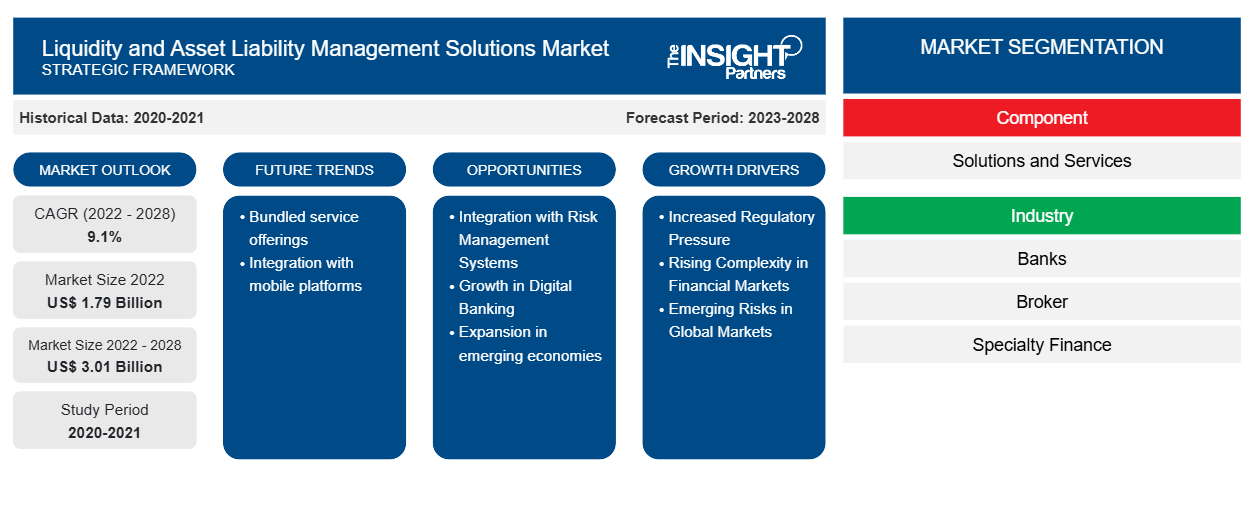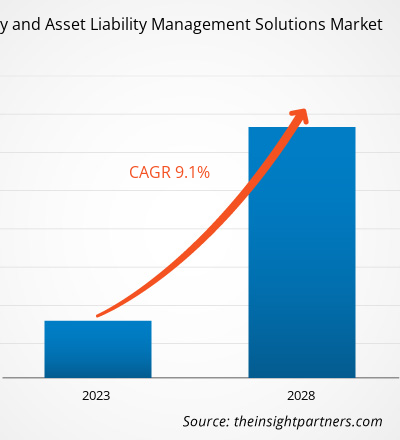The liquidity and asset liability management solutions market size is projected to grow from US$ 1,787.59 million in 2022 to US$ 3,009.24 million by 2028; it is estimated to grow at a CAGR of 9.1% from 2022 to 2028.
Liquidity management can be referred to as an institution's act of ensuring the availability of sufficient cash and liquid assets for paying the institution's expenses and satisfying any client's loan or savings withdrawal demand. Asset liability management is the process of planning, organizing, and controlling asset and liability volumes, maturities, rates, and yields to minimize interest rate risk and maintain an acceptable profitability level. Liquidity and asset liability management solutions and services aid enterprises manage liquidity and asset liability effectively.
Growing stringency of regulations and rising attention to interest rate risk have been forcing banking institutions to seek comprehensive liquidity and asset liability management solutions. Interest Rate Risk in Banking Book (IRRBB) and EBA stress test under funding planning are some factors that require banks to assess the possible after-effects of an increase in interest rate, the change in values of interest-sensitive assets, and the resultant decrease in regulatory capital. In addition, the BFSI sector has been witnessing increasing regulations related to risk management. Furthermore, persistent fluctuations in interest rates across the US, the UK, Switzerland, Japan, and other large banking nations have diminished the BFSI sector's margins. Such factors have promoted the global liquidity and asset liability management solutions market growth. These solutions and services can allow financial institutions to undertake decisions based on scenario analysis, provide a better perspective from both risk and finance-based views, and strongly aid enterprises in complying with regulatory requirements. Most modern-day liquidity and asset liability solutions have integrated funds transfer pricing (FTP), allowing users to distinguish between the profitability of one activity with another.
Based on the liquidity and asset liability management solutions market report, the liquidity and asset liability management solutions market is segmented into component and industry. Based on component, the liquidity and asset liability management solutions market is segmented into solutions and services. Based on industry, the liquidity and asset liability management solutions market is segmented into banks, brokers, specialty finance, wealth advisors, and others.
Customize This Report To Suit Your Requirement
You will get customization on any report - free of charge - including parts of this report, or country-level analysis, Excel Data pack, as well as avail great offers and discounts for start-ups & universities
Liquidity and Asset Liability Management Solutions Market: Strategic Insights

-
Get Top Key Market Trends of this report.This FREE sample will include data analysis, ranging from market trends to estimates and forecasts.
Impact of COVID-19 Pandemic on Liquidity and Asset Liability Management Solutions Market Size
With the social restrictions imposed by various countries in response to the onset of the COVID-19 pandemic, major stakeholders in the BFSI sector—such as banks, brokers, and wealth advisors—turned to digital platforms to meet their everyday needs. Digital wallets, often known as eWallets, became more popular amid these conditions. As a result of this transition, the likelihood of credit loss and nonperforming assets (NPAs) increased, while banks experienced unexpected asset liability management (ALM) model results. The Financial Action Task Force (FATF) has cautioned banks about unlawful money transactions. As a result, demand for liquidity and asset liability management solutions has surged, significantly influencing the liquidity and asset liability management solutions market growth. Moreover, owing to the widespread use of digital platforms, the volume of data on networks is growing, putting much strain on banks and financial institutions to timely maintain their balance sheets. Most regional and international banks have experienced significantly lower loan yields and margins than anticipated due to higher loan refinancing. The COVID-19 pandemic has accelerated developments in digital technologies and digital liquidity. Hence, banks and financial institutions are now using data analytics techniques to improve their asset management processes.
Market Insights – Liquidity and Asset Liability Management Solutions Market Analysis
Growth of BNPL Industry
The progressive buy-now-pay-later (BNPL) industry is also supporting the growth of the liquidity and asset liability management solutions market. Effective credit risk and liability management is the key to success for BNPL players. Based on a report by Apptopia, BNPL app downloads reached 6.8 million in November 2021, up by 54% from November 2020, and monthly active users (MAU) increased by 63% year-over-year. Although the US leads the race, the number of active users in Europe has also grown significantly. Based on a report by PayU, 7.4% of total e-commerce transactions in Europe happened using BNPL services in 2020, and the transaction count is expected to grow by 45% over the next five years. Hence, with the globally proliferating BNPL industry, coupled with the growing focus on liability risk by industry players, the liquidity and asset liability management solutions market growth is anticipated at a good pace during the forecast period.
Component-Based Liquidity and Asset Liability Management Solutions Market Insights
Based on component, the liquidity and asset liability management solutions market is segmented into solutions and services. The solutions segment is expected to be the fastest-growing segment, primarily promoted by the advent of AI-enabled solutions. The services segment is expected to grow at a moderate pace during the forecast period.
End User-Based Liquidity and Asset Liability Management Solutions Market Insights
In terms of industry, the global liquidity and asset liability solutions market is segmented into banks, brokers, specialty finance, wealth advisors, and others. The banks segment is anticipated to be the largest segment during the forecast period, owing to the widespread adoption of liquidity and asset liability solutions across the globe.
Liquidity and asset liability management solutions market players are mainly focused on developing advanced and efficient products. A few examples are given below.
- In June 2022, Infosys Finacle, part of EdgeVerve Systems—a wholly-owned subsidiary of Infosys and Suryoday Small Finance Bank (SSFB) announced the successful implementation of the Finacle Core Banking Platform and Finacle Treasury Platform. Finacle will support SSFB's retail, corporate, and payment engines in an on-premise model supported by IBM's infrastructure stack.
- In February 2022, Data analytics and AI technology giant SAS acquired Honolulu-based Kamakura Corp., which will expand its reach within the financial services industry and broaden the SAS portfolio of financial risk management software. It is one of the leading companies in the data analytics and data management arena.
The regional trends and factors influencing the Liquidity and Asset Liability Management Solutions Market throughout the forecast period have been thoroughly explained by the analysts at The Insight Partners. This section also discusses Liquidity and Asset Liability Management Solutions Market segments and geography across North America, Europe, Asia Pacific, Middle East and Africa, and South and Central America.
Liquidity and Asset Liability Management Solutions Market Report Scope
| Report Attribute | Details |
|---|---|
| Market size in 2022 | US$ 1.79 Billion |
| Market Size by 2028 | US$ 3.01 Billion |
| Global CAGR (2022 - 2028) | 9.1% |
| Historical Data | 2020-2021 |
| Forecast period | 2023-2028 |
| Segments Covered |
By Component
|
| Regions and Countries Covered |
North America
|
| Market leaders and key company profiles |
|
Liquidity and Asset Liability Management Solutions Market Players Density: Understanding Its Impact on Business Dynamics
The Liquidity and Asset Liability Management Solutions Market is growing rapidly, driven by increasing end-user demand due to factors such as evolving consumer preferences, technological advancements, and greater awareness of the product's benefits. As demand rises, businesses are expanding their offerings, innovating to meet consumer needs, and capitalizing on emerging trends, which further fuels market growth.

- Get the Liquidity and Asset Liability Management Solutions Market top key players overview
Company Profiles: Liquidity and Asset Liability Management Solutions Market
- Experian Information Software, Inc.
- Fidelity National Information Services, Inc.
- Finastra International Limited
- IBM Corporation
- Infosys, Ltd.
- Intellect Design Arena Limited
- Moody's Corporation
- Oracle Corporation
- SAP SE
- Wolters Kluwer N.V
Frequently Asked Questions
What is the incremental growth of the liquidity and asset liability management solutions market during the forecast period?
Which is the leading component segment in the liquidity and asset liability management solutions market?
What will be the global market size for liquidity and asset liability management solutions market by 2028?
Which is the fastest growing regional market?
Which countries are registering a high growth rate during the forecast period?
Which country is holding the major market share of liquidity and asset liability management solutions market?
Which are the key players holding the major market share of liquidity and asset liability management solutions market?
What are the future trends for liquidity and asset liability management solutions market?
What are the driving factors impacting the global liquidity and asset liability management solutions market?
What is the estimated global market size for liquidity and asset liability management solutions market?
- Historical Analysis (2 Years), Base Year, Forecast (7 Years) with CAGR
- PEST and SWOT Analysis
- Market Size Value / Volume - Global, Regional, Country
- Industry and Competitive Landscape
- Excel Dataset
Recent Reports
Testimonials
Reason to Buy
- Informed Decision-Making
- Understanding Market Dynamics
- Competitive Analysis
- Identifying Emerging Markets
- Customer Insights
- Market Forecasts
- Risk Mitigation
- Boosting Operational Efficiency
- Strategic Planning
- Investment Justification
- Tracking Industry Innovations
- Aligning with Regulatory Trends





















 Get Free Sample For
Get Free Sample For